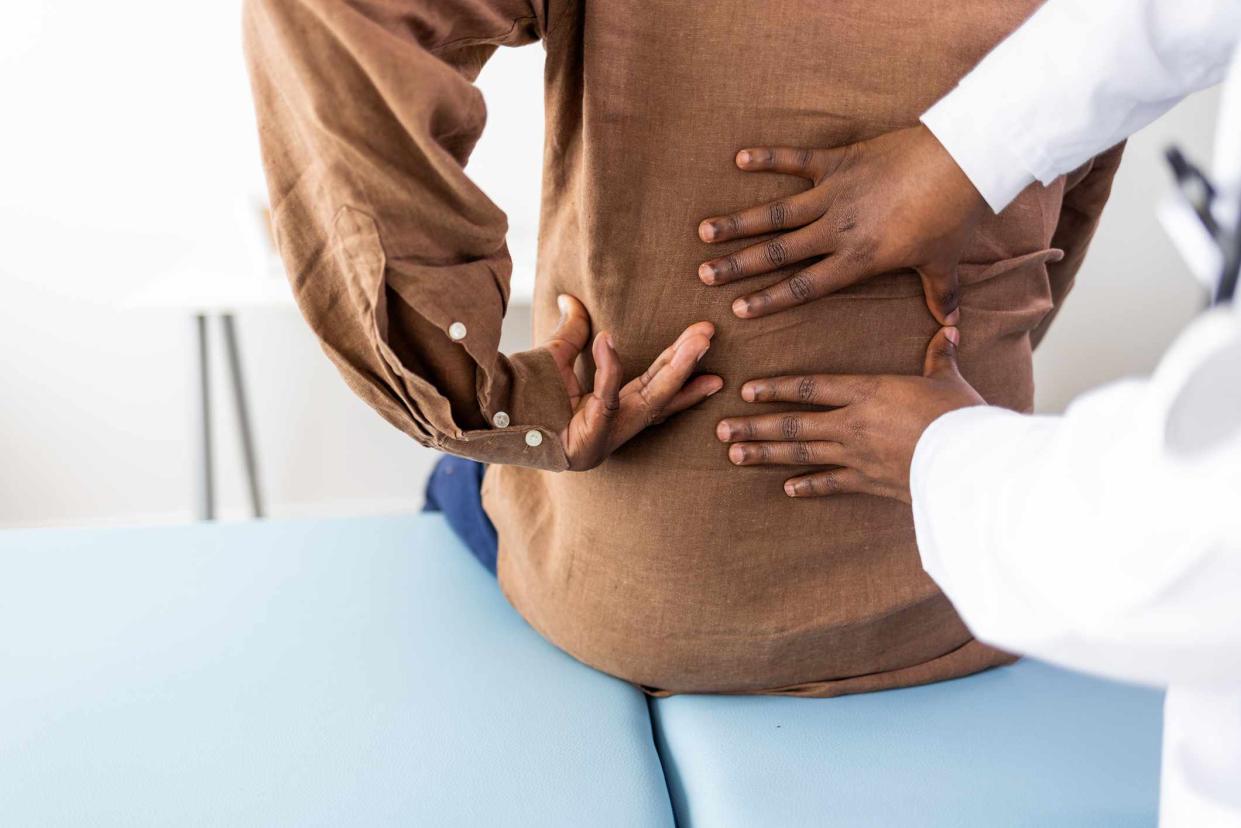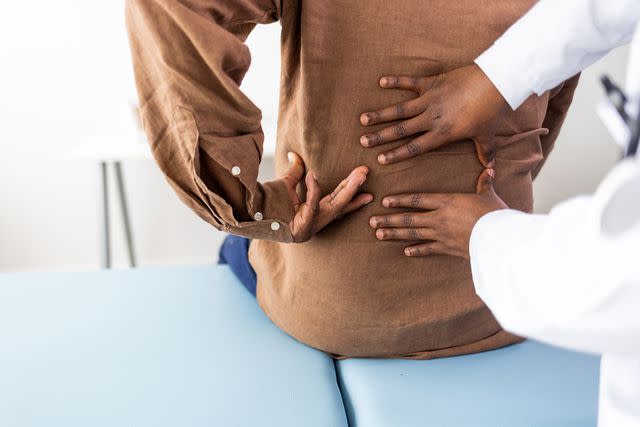What Is Anterolisthesis?

ljubaphoto / Getty Images
Your spine is made up of 33 individual bones, called vertebrae, that are stacked on top of one another. Anterolisthesis occurs when one of these vertebrae slips forward compared with the one beneath it.
Many different things, including osteoarthritis, osteoporosis, trauma, or a fracture, can cause this vertebral movement to occur. This article will describe the symptoms, diagnosis, and treatments for anterolisthesis.

ljubaphoto / Getty Images
Grades of Anterolisthesis
Anterolisthesis is typically graded using the Meyerding scale, which assigns one of five grades according to how much slippage has occurred. These grades include:
Grade 1: 0 to 25% slippage
Grade 2: 25 to 50% slippage
Grade 3: 50 to 75% slippage
Grade 4: 75 to 100% slippage
Grade 5: More than 100% slippage (also known as spondyloptosis)
Grade 1 and 2 anterolisthesis cases are generally considered mild in nature, while grades 3, 4, and 5 cases are considered to be more severe.
"Spondylolisthesis" is a general term that refers to the shifting of one spinal vertebra over the one beneath it. This catchall category includes both anterolisthesis (forward shifting) and the less common retrolisthesis (backward shifting).
Anterolisthesis Symptoms
Anterolisthesis can lead to a wide variety of symptoms, depending on the severity and whether the surrounding spinal nerves are affected. Some of the most common complaints associated with this condition include:
Low-back pain or stiffness
Shooting pain into the leg
Weakness when standing or walking for long periods of time
Cramping in the leg muscles
Numbness or tingling in the leg that improves when sitting or bending forward
Causes
Cases of anterolisthesis are also typically categorized based on what led to the condition. The most common causes include:
Degenerative anterolisthesis: Slippage that occurs when arthritis (also known as spondylosis) causes the spine’s joints and discs to deteriorate
Isthmic anterolisthesis: Slippage caused by a fracture in a portion of the spine called the pars (also known as a pars defect)
Congenital or dysplastic anterolisthesis: Vertebral slippage caused by a condition present at birth or spinal abnormality
Traumatic anterolisthesis: Acute slippage of the vertebrae caused by a traumatic injury
Pathologic anterolisthesis: Anterolisthesis occurring because of a bone disease like osteoporosis
Iatrogenic (postsurgical) anterolisthesis: Slippage that occurs as a result of a prior spinal decompression procedure
The degenerative version of the anterolisthesis is the most common, particularly in women and adults over the age of 50. In addition, Black Americans tend to experience this condition at a higher rate than the general population.
Note that when health authorities are cited, the terms for sex or gender from the source are used.
Diagnosis
Diagnosis of anterolisthesis begins with a subjective evaluation and a physical exam. Your healthcare provider will typically assess your sensation, strength, and reflexes during this time. They may also order one of several diagnostic tests, including:
X-ray: Visualizes the vertebrae in your spine and their position relative to the ones above and below. This test also provides a clear picture of any spinal arthritis or disc degeneration.
Magnetic resonance imaging (MRI): Allows the spinal cord, spinal nerves, muscles, and discs to be assessed for any compression or damage.
Computed tomography (CT) scan: Provides a cross-sectional image of the spine in very clear detail.
Be evaluated immediately if you are experiencing severe back pain, incontinence (lack of control) of your bowel or bladder, progressive weakness, or giving way of your legs.
Treatment
Several factors play a role in deciding how to treat anterolisthesis. These include:
The grade of the slippage
The cause of the condition
The symptoms that are present
The presence of instability on an X-ray
Stable and mildly symptomatic cases are typically treated with a combination of several interventions:
Nonsteroidal anti-inflammatory drugs (NSAIDs) such as Advil (ibuprofen)
Bracing
Activity modification
In more severe cases in which spinal instability or significant neurological symptoms are present, surgery may be needed. This commonly involves a spinal decompression or fusion procedure, though the technique varies based on your surgeon’s preferences and the anatomy that is involved.
Prognosis
Anterolisthesis is generally not considered to be a serious problem. Many people with this condition don’t know they have it until it is found incidentally on an X-ray or an MRI. Mild cases typically cause minimal (if any) symptoms and are well-managed with the conservative treatments described above.
Cases of unstable anterolisthesis or those with neurological compression commonly need surgical intervention. These operations strive to restore stability to the spine and alleviate any pressure on the spinal nerves.
The American Academy of Orthopaedic Surgeons reports that more than 85% of people with anterolisthesis who require surgery have a successful clinical outcome afterward.
Related:Causes of Back Pain and Treatment Options
Coping
If you are experiencing pain, numbness, or tingling from anterolisthesis, getting your symptoms evaluated by a healthcare provider is an important first step. Once they have ruled out any red flags, your healthcare provider may suggest one of several coping strategies. These commonly include:
Focus on the core: Exercises that target the core muscles in your hips, pelvis, abdomen, and low back can help alleviate some of your symptoms. Formal physical therapy may also be recommended.
Try over-the-counter medications: Your healthcare provider may suggest taking pain-relieving medications like aspirin, Advil or Motrin (ibuprofen), or Aleve (naproxen) to reduce some of your soreness.
Change your activities: Sticking to gentle, pain-free activities and avoiding excessive or repetitive extension of the spine can help you prevent symptom aggravation.
Summary
Anterolisthesis occurs when one vertebral segment slips forward over another segment in your spine. This condition can be mild and asymptomatic or cause significant pain and neurological symptoms.
Many people with anterolisthesis are able to manage their condition with conservative measures like activity modification and participating in physical therapy. Those with severe cases or who fail to improve may need spinal injections or a surgical procedure.

